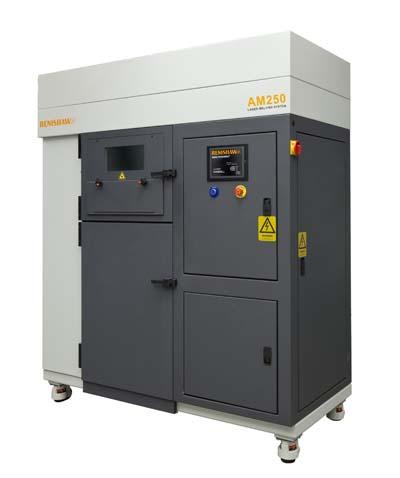
Renishaw's new laser melting additive-metal manufacturing process is capable of producing fully dense metal parts direct from 3D CAD data using a high-powered fiber laser. Parts are built layer by layer, in thicknesses ranging from 20 to 100µm, using a range of fine metal powders that are fully melted in a tightly controlled atmosphere.
The current range of machines utilizes a third-generation design representing state-of-the-art manufacturing technology. Key features include variable powder delivery, ultra low oxygen content in the build atmosphere, and an unparalleled safe-change filter system to minimize user contact with materials.
Two systems are available: the AM125 and the AM250, both of which feature vacuum technology and low gas consumption. Both utilize "machine tool" engineering in design, operation, and serviceability, emphasizing ruggedness and ease of operation. The touch-screen operator interface includes menu options for machine preparation and clean down. Consumable costs are minimized through features such as the soft re-coater blade that can be rotated several times before replacement, use of low-cost filter elements, and low gas consumption – all of which improve system reliability and cost of ownership.
Renishaw additive-metal systems process a wide variety of materials, including 316L and 17-4PH SS, H13 tool steel, aluminum Al-Si-12, titanium CP, Ti-6Al-4V and 7Nb, cobalt-chrome (ASTM75), and Inconel 718 and 625. Both systems are designed for rapid material changeover, with the AM125 utilizing a cassette type materials delivery system and the AM250 a removable hopper, particularly useful for materials development or use of a range of materials. To enhance productivity, a valve interlock on the AM250 allows addition of extra powder while the process is running. Safe processing of reactive materials, such as titanium and aluminum, is ensured with features such as a gas knife that clears away reactive, sooty emissions, and a heated build plate.
The AM125 provides a part-build volume of 125 x 125 x 125mm (X-Y-Z), and the AM250 provides 250 x 250 x 300mm (X-Y-Z) with Z axis extendable to 360mm. Both have build rates of 5 to 20 cm3 per hour, dependent on the material, part density and geometry.
The AM125 offers a choice of 100 or 200 W laser, and the AM250 a 200 or 400 W laser. Both the new machines feature a fully welded vacuum chamber, enabling low-pressure evacuation followed by a recharge with high purity argon gas. Gas consumption, after the initial chamber flood, is extremely low, and allows operation at oxygen concentrations below 50 parts per million – crucial when processing reactive materials, and contributing significantly to material integrity and mechanical performance.
All file preparation is completed off-line through a choice of interface, either Marcam Autofab software or Materialise Magics. Once complete, the build file is uploaded to the machine via a secure network or direct connection. Product traceability has been improved by the addition of process data and event logging as standard, with various additional process control options on request.
Contact Details
Related Glossary Terms
- computer-aided design ( CAD)
computer-aided design ( CAD)
Product-design functions performed with the help of computers and special software.
- lapping compound( powder)
lapping compound( powder)
Light, abrasive material used for finishing a surface.
- process control
process control
Method of monitoring a process. Relates to electronic hardware and instrumentation used in automated process control. See in-process gaging, inspection; SPC, statistical process control.
